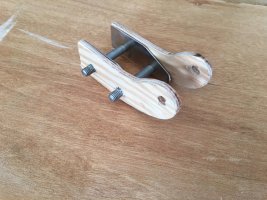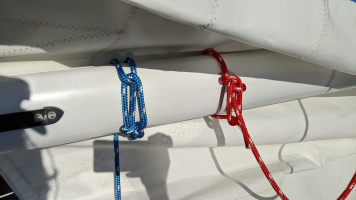This is great -- well, not the boom/gooseneck gap, but the identification and suggestions. I'll plan on looking more at the gooseneck at the next opportunity. Is it recommended to take the boom completely off to inspect? Should I consider starting another thread to continue talking about this?
Guest viewing is limited
- You have a limited number of page views remaining
- 26 guest views remaining
- Register now to remove this limitation
You are using an out of date browser. It may not display this or other websites correctly.
You should upgrade or use an alternative browser.
You should upgrade or use an alternative browser.
Sure, start a new thread--or better yet, locate an existing gooseneck thread and revive it.
Don't have to remove the boom for the setup issues since that gear is all exterior.
Maybe you can just bang the gooseneck back flush with the boom section with a padded hammer, then drill a second hole to keep it in place.
When I do take the boom off, I tie the halyard around it so that, when the gooseneck is detached from the mast, the boom hangs level from the halyard and from the topping lift. Then you can take the gooseneck off the boom and work on the interior outhaul and reef lines without removing them.
Don't have to remove the boom for the setup issues since that gear is all exterior.
Maybe you can just bang the gooseneck back flush with the boom section with a padded hammer, then drill a second hole to keep it in place.
When I do take the boom off, I tie the halyard around it so that, when the gooseneck is detached from the mast, the boom hangs level from the halyard and from the topping lift. Then you can take the gooseneck off the boom and work on the interior outhaul and reef lines without removing them.
This boat has a rigid vang and no topping lift. The main halyard is usually connected to the end of the boom when at the dock. So I suppose I could take the slack out of the boomvang control line (to keep the springs in the rigid vang from pushing the boom any higher when disconnected) and leave the halyard as the temporary topping lift for this work.
Cool! Welcome! Where are you keeping your boat?
I took my boom off this fall for rehab and I think, especially if you are considering tapping new holes to tighten up your gooseneck gap, it would be easier to do the work not swinging around on deck. The disassembly is not complicated, though the boom is a bit unwieldy to carry around. It looks like my '90 Kenyon boom (same white paint etc.) may have four 'extra' screws connecting the gooseneck to the boom, that do not appear to be present on yours.
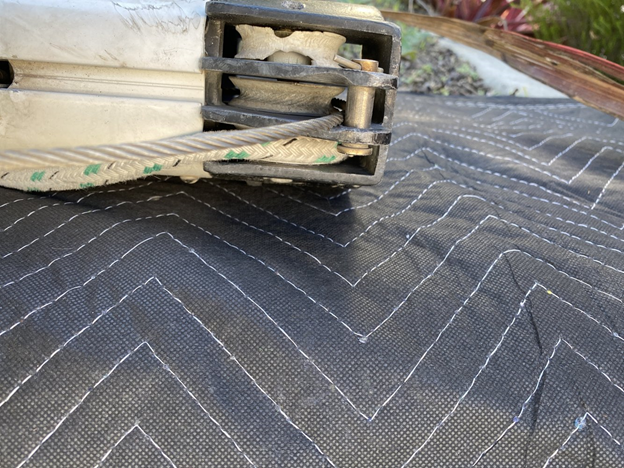
 ericsonyachts.org
ericsonyachts.org
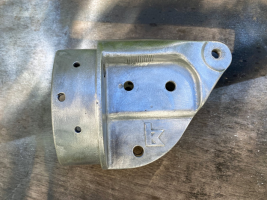
I took my boom off this fall for rehab and I think, especially if you are considering tapping new holes to tighten up your gooseneck gap, it would be easier to do the work not swinging around on deck. The disassembly is not complicated, though the boom is a bit unwieldy to carry around. It looks like my '90 Kenyon boom (same white paint etc.) may have four 'extra' screws connecting the gooseneck to the boom, that do not appear to be present on yours.
E32-200 - Boom rehab
Another Novice Note: After some initial sails and testing, I came up with a list of updates that I wanted to make to my boom. Planning 1. Remove & replace the frozen reef line sheave at the aft cap end. (Replace both sheaves as they are of...

Hi Tom! Thanks for the welcome and info. Still looking for a berth, but hoping for Brickyard Cove or Berkeley Marina. I really like Brickyard for the weather/newness and Berkeley for its positioning relative to The Slot and typical SF west wind -- makes for a nice downwind sail home. Any other suggestions for SF Bay?
Interesting about the extra holes. I'll check when I take everything apart this week to see what's underneath on my gooseneck. Thanks for linking your blog post on boom rehab. I'll figure out the best place to put some photos and info in what I find. I also have a frozen sheave at the end of the boom. I'll probably just order and replace all of the sheaves for good measure while I'm at it.
Christian et al, possible to order those Hunsinker (sp?) plates to reinforce the gooseneck attachment to mast?
Interesting about the extra holes. I'll check when I take everything apart this week to see what's underneath on my gooseneck. Thanks for linking your blog post on boom rehab. I'll figure out the best place to put some photos and info in what I find. I also have a frozen sheave at the end of the boom. I'll probably just order and replace all of the sheaves for good measure while I'm at it.
Christian et al, possible to order those Hunsinker (sp?) plates to reinforce the gooseneck attachment to mast?
Tom, my gooseneck did not have the extra holes shown on yours. I suspect I'll need to drill new. I'm documenting my shenanigans on a new thread: https://ericsonyachts.org/ie/threads/e32-boom-gooseneck-fitment-rehab.17787/ Please feel free to drop in and comment 
Also, how did you remove the retaining clip on the center sheave for the topping lift?
Also, how did you remove the retaining clip on the center sheave for the topping lift?
Hey Bryan - For your berth, you can find a marina in almost any part of the SF bay, except for those unobtainable beautiful slips on the Marina Green in SF. The wait-list for a 30+ foot boat is multiple years, from what I have gathered. I found a spot in Sausalito with which I am happy because I can get to the marina from my house in 15 minutes and there is a West Marine store 10 minutes away. Every place will have advantages and disadvantages.
I think that in order to remove the axle pin for your topping lift sheave, you need to un-clip the retaining ring (horseshoe-shaped flat metal piece with two tiny holes) shown in your first picture. I think when I did it, I used a screwdriver or two to flex out the open end of the clip and then tried to push it off (without permanently bending or damaging the clip). Apply WD40 or something to the pin to facilitate the sliding. If you can get some needle-nosed pliers on the closed side of the horseshoe, pulling is also possible. If there is a more elegant way, I don't know it. 100% chance that the clip will finally ping off the axle in a random direction, so make appropriate preparations to find where it may land.
I think that in order to remove the axle pin for your topping lift sheave, you need to un-clip the retaining ring (horseshoe-shaped flat metal piece with two tiny holes) shown in your first picture. I think when I did it, I used a screwdriver or two to flex out the open end of the clip and then tried to push it off (without permanently bending or damaging the clip). Apply WD40 or something to the pin to facilitate the sliding. If you can get some needle-nosed pliers on the closed side of the horseshoe, pulling is also possible. If there is a more elegant way, I don't know it. 100% chance that the clip will finally ping off the axle in a random direction, so make appropriate preparations to find where it may land.
Mr. Scarlett
Member III
I'd like to revive this thread to ask if anyone has a boom (1979 35-2) whose forward end looks like this:
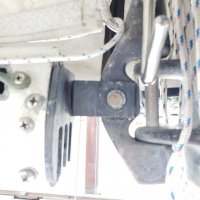
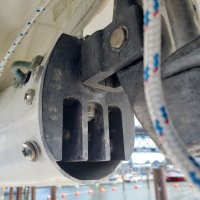
Right now the two reef lines and the outhaul exit the boom through their own holes (roughly 4, 6, and 8 o'clock if looking at a cross section), and go on their own cleats. There's no winch available for any of the three lines. It looks to me like there was an axle and three sheaves - that's straightforward enough, but then to where? There's no evidence of a winch on the aft face of the mast, and given the space between the boom and mast, that winch would have to be on one heck of a spacer to catch the lines at the right angle to avoid overrides. I want to be able to winch the reef outhaul home. Since I'll be going forward to put the dog bone on the hook I don't mind finishing the reef at the mast. I have a suitable winch and only need to mount it.
Has anyone seen how the forward end of these booms was finished off? The Rig Rite options I've seen don't quite seem right to me. Hopefully someone who has seen these before will chime in.
Hmmm, I suppose that the lines could run down to the deck and then up to a winch. This introduces some friction however.
Open to suggestions! Thanks in advance.


Right now the two reef lines and the outhaul exit the boom through their own holes (roughly 4, 6, and 8 o'clock if looking at a cross section), and go on their own cleats. There's no winch available for any of the three lines. It looks to me like there was an axle and three sheaves - that's straightforward enough, but then to where? There's no evidence of a winch on the aft face of the mast, and given the space between the boom and mast, that winch would have to be on one heck of a spacer to catch the lines at the right angle to avoid overrides. I want to be able to winch the reef outhaul home. Since I'll be going forward to put the dog bone on the hook I don't mind finishing the reef at the mast. I have a suitable winch and only need to mount it.
Has anyone seen how the forward end of these booms was finished off? The Rig Rite options I've seen don't quite seem right to me. Hopefully someone who has seen these before will chime in.
Hmmm, I suppose that the lines could run down to the deck and then up to a winch. This introduces some friction however.
Open to suggestions! Thanks in advance.
My reefing outhauls are as Toddster describes. Out of the gooseneck, down to a turning block, then through a deck organizer, back through a clutch, to the cabin top where the lines can be winched.
There is some friction but I believe this is the intention of the style of boom.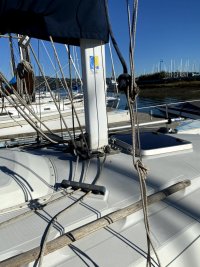
My main outhaul is cleated at the mast and generally not adjusted.
Hope this helps,
There is some friction but I believe this is the intention of the style of boom.

My main outhaul is cleated at the mast and generally not adjusted.
Hope this helps,
My reefing outhauls are as Toddster describes. Out of the gooseneck, down to a turning block, then through a deck organizer, back through a clutch, to the cabin top where the lines can be winched.
Same here.
I do use a separate thing for the reefing tackline - I made up a 2:1 tackle from a block with a reefing-hook at the top, and a block with a becket, snap-shackle and cam-cleat at the bottom. Easy enough to put the hook through the dog-bone on the luff and snap the snap-shackle to the mast collar when the forecast indicates I may be reefing. The tail is long enough that I can put it on a winch if needed (although I haven't yet needed to.
This tackle is also useful for other things. For example, hooked to the boom-vang bail and clipped to a car on the rail, makes a good boom-preventer, which I can harden up or ease from the cockpit...
Mr. Scarlett
Member III
Thanks for the replies. I'd like to avoid going down the path of running lines to the cockpit. I'm leaning towards the same turning blocks at the base of the mast, but then up to a winch between the boom and vang.
Those cams are a pain. I just replaced my reefing lines and led the lines down from the gooseneck to a block at the bottom of the mast. This lets me lead the lines back to the cockpit or pull the line upwards to get enough foot tension and then cleat off on a cleat at the sides of the mast.The gooseneck fitting sheaves have small cam levers to hold a reef line under tension. These are visible in the gooseneck photos. They do not work very well, and are to be removed if the reef lines are led back to the cockpit and a winch. (A winch is really mandatory for reef lines; it is very difficult to haul a reef tight without one).
I'll take some pics.
Hcard
Member III
Hi Vanilladuck. I have the setup as you. The two reefing lines sticking out at the end of the boom. Could you please explain or shoot me a little diagram of how do you use these two lines to reef the sail?’ Many thanks for your help.Thanks, Christian - I took your adviceAlso took the opportunity to remove the cam levers. Should I be putting a spacer in place of the cam levers? I just put the bolt back in and tightened the self-locking nut until it grabbed some threads without putting any pressure on the new reefing lines running into the boom. The metal guide plate is just ever so slightly loose, but I'm guessing there's nothing to foul here.
Hi Hugo! The two reefing lines which attach to the leech of the mainsail go down and through the boom, through a few turning blocks they arrive back in the cockpit. When reefing, the lines can be controlled from the cockpit on a winch instead of needing to move forward to the mast. Helps with single-handing or if one is just feeling lazyHi Vanilladuck. I have the setup as you. The two reefing lines sticking out at the end of the boom. Could you please explain or shoot me a little diagram of how do you use these two lines to reef the sail?’ Many thanks for your help.
It's likely that we have the same Kenyon boom on our boat. This subject comes up regularly, and different owners have evolved slightly different solutions. You might try a search on 'reefing lines' or similar.
I have considered going back to the factory T track, but that's a decision for another month.
 ericsonyachts.org
ericsonyachts.org
I have considered going back to the factory T track, but that's a decision for another month.
Reefing Line Leads
I am pretty sure that we have an older thread around here somewhere discussing ways of leading the clew reef lines. Can't find it offhand... :rolleyes: I did just run across a nice video on-line showing how to set up the line to put the correct (approx) 45 degree pull on that reef line that we...
Hcard
Member III
Got it, thanks you!!The main sail should have some cringles (eyelets) on the leech. The reefing line would run from the sheaves in the end of the boom up through the cringle and then back down to the boom. Most folks secure with a bowline around the line itself so it cinches around the boom when tension is applied.
View attachment 41454

